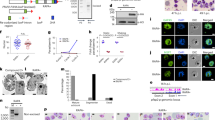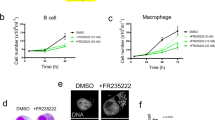Abstract
The protozoan parasite Toxoplasma gondii has co-evolved with its homeothermic hosts (humans included) strategies that drive its quasi-asymptomatic persistence in hosts, hence optimizing the chance of transmission to new hosts. Persistence, which starts with a small subset of parasites that escape host immune killing and colonize the so-called immune privileged tissues where they differentiate into a low replicating stage, is driven by the interleukin 12 (IL-12)–interferon-γ (IFN-γ) axis. Recent characterization of a family of Toxoplasma effectors that are delivered into the host cell, in which they rewire the host cell gene expression, has allowed the identification of regulators of the IL-12–IFN-γ axis, including repressors. We now report on the dense granule-resident effector, called TEEGR (Toxoplasma E2F4-associated EZH2-inducing gene regulator) that counteracts the nuclear factor-κB (NF-κB) signalling pathway. Once exported into the host cell, TEEGR ends up in the nucleus where it not only complexes with the E2F3 and E2F4 host transcription factors to induce gene expression, but also promotes shaping of a non-permissive chromatin through its capacity to switch on EZH2. Remarkably, EZH2 fosters the epigenetic silencing of a subset of NF-κB-regulated cytokines, thereby strongly contributing to the host immune equilibrium that influences the host immune response and promotes parasite persistence in mice.
This is a preview of subscription content, access via your institution
Access options
Access Nature and 54 other Nature Portfolio journals
Get Nature+, our best-value online-access subscription
$29.99 / 30 days
cancel any time
Subscribe to this journal
Receive 12 digital issues and online access to articles
$119.00 per year
only $9.92 per issue
Buy this article
- Purchase on Springer Link
- Instant access to full article PDF
Prices may be subject to local taxes which are calculated during checkout






Similar content being viewed by others
References
Jeffers, V., Tampaki, Z., Kim, K. & Sullivan, W. J. A latent ability to persist: differentiation in Toxoplasma gondii. Cell. Mol. Life Sci. 75, 2355–2373 (2018).
Melo, M. B., Jensen, K. D. C. & Saeij, J. P. J. Toxoplasma gondii effectors are master regulators of the inflammatory response. Trends Parasitol. 27, 487–495 (2011).
Hunter, C. A. & Sibley, L. D. Modulation of innate immunity by Toxoplasma gondii virulence effectors. Nat. Rev. Microbiol. 10, 766–778 (2012).
Bougdour, A. et al. Host cell subversion by Toxoplasma GRA16, an exported dense granule protein that targets the host cell nucleus and alters gene expression. Cell Host Microbe 13, 489–500 (2013).
Braun, L. et al. A Toxoplasma dense granule protein, GRA24, modulates the early immune response to infection by promoting a direct and sustained host p38 MAPK activation. J. Exp. Med. 210, 2071–2086 (2013).
Gay, G. et al. Toxoplasma gondii TgIST co-opts host chromatin repressors dampening STAT1-dependent gene regulation and IFN-γ-mediated host defenses. J. Exp. Med. 213, 1779–1798 (2016).
Olias, P., Etheridge, R. D., Zhang, Y., Holtzman, M. J. & Sibley, L. D. Toxoplasma effector recruits the Mi-2/NuRD complex to repress STAT1 transcription and block IFN-γ-dependent gene expression. Cell Host Microbe 20, 72–82 (2016).
Hakimi, M.-A., Olias, P. & Sibley, L. D. Toxoplasma effectors targeting host signaling and transcription. Clin. Microbiol. Rev. 30, 615–645 (2017).
Fischer, M., Grossmann, P., Padi, M. & DeCaprio, J. A. Integration of TP53, DREAM, MMB-FOXM1 and RB-E2F target gene analyses identifies cell cycle gene regulatory networks. Nucleic Acids Res. 44, 6070–6086 (2016).
Marson, A. et al. Foxp3 occupancy and regulation of key target genes during T-cell stimulation. Nature 445, 931–935 (2007).
Julian, L. M. et al. Tissue-specific targeting of cell fate regulatory genes by E2f factors. Cell Death Differ. 23, 565–575 (2016).
Zheng, N., Fraenkel, E., Pabo, C. O. & Pavletich, N. P. Structural basis of DNA recognition by the heterodimeric cell cycle transcription factor E2F–DP. Gene Dev. 13, 666–764 (1999).
Margueron, R. & Reinberg, D. The Polycomb complex PRC2 and its mark in life. Nature 469, 343–349 (2011).
Bracken, A. P. et al. EZH2 is downstream of the pRB-E2F pathway, essential for proliferation and amplied in cancer. EMBO J. 22, 5323–5335 (2003).
Garber, M. et al. A high-throughput chromatin immunoprecipitation approach reveals principles of dynamic gene regulation in mammals. Mol. Cell 47, 810–822 (2012).
Xing, Y., Zhou, F. & Wang, J. Subset of genes targeted by transcription factor NF-κB in TNFα-stimulated human HeLa cells. Funct. Integr. Genomics 13, 143–154 (2013).
Luo, X., Chae, M., Krishnakumar, R., Danko, C. G. & Kraus, W. Dynamic reorganization of the AC16 cardiomyocyte transcriptome in response to TNFα signaling revealed by integrated genomic analyses. BMC Genom. 15, 155 (2014).
Afonina, I. S., Zhong, Z., Karin, M. & Beyaert, R. Limiting inflammation—the negative regulation of NF-κB and the NLRP3 inflammasome. Nat. Immunol. 18, 861–869 (2017).
Sun, F. et al. Combinatorial pharmacologic approaches target EZH2-mediated gene repression in breast cancer cells. Mol. Cancer Ther. 8, 3191–3202 (2009).
Lee, S. T. et al. Context-specific regulation of NF-κB target gene expression by EZH2 in breast cancers. Mol. Cell 43, 798–810 (2011).
Liu, Y. et al. Epithelial EZH2 serves as an epigenetic determinant in experimental colitis by inhibiting TNFα-mediated inflammation and apoptosis. Proc. Natl Acad. Sci. USA 114, E3796–E3805 (2017).
McCabe, M. T. et al. EZH2 inhibition as a therapeutic strategy for lymphoma with EZH2-activating mutations. Nature 492, 108–112 (2012).
Howard, J. C., Hunn, J. P. & Steinfeldt, T. The IRG protein-based resistance mechanism in mice and its relation to virulence in Toxoplasma gondii. Curr. Opin. Microbiol. 14, 414–421 (2011).
Virreira Winter, S. et al. Determinants of GBP recruitment to Toxoplasma gondii vacuoles and the parasitic factors that control it. PLoS ONE 6, e24434 (2011).
Robben, P. M., LaRegina, M., Kuziel, W. A. & Sibley, L. D. Recruitment of Gr-1+ monocytes is essential for control of acute toxoplasmosis. J. Exp. Med. 201, 1761–1769 (2005).
Dunay, I. R. et al. Gr1(+) inflammatory monocytes are required for mucosal resistance to the pathogen Toxoplasma gondii. Immunity 29, 306–317 (2008).
Mordue, D. G., Monroy, F., La Regina, M., Dinarello, C. A. & Sibley, L. D. Acute toxoplasmosis leads to lethal overproduction of Th1 cytokines. J. Immunol. 167, 4574–4584 (2001).
Chang, H. R., Grau, G. E. & Pechère, J. C. Role of TNF and IL-1 in infections with Toxoplasma gondii. Immunology 69, 33–37 (1990).
Hunter, C. A., Chizzonite, R. & Remington, J. S. IL-1 beta is required for IL-12 to induce production of IFN-gamma by NK cells. A role for IL-1 beta in the T cell-independent mechanism of resistance against intracellular pathogens. J. Immunol. 155, 4347–4354 (1995).
Rosowski, E. E. et al. Strain-specific activation of the NF-κB pathway by GRA15, a novel Toxoplasma gondii dense granule protein. J. Exp. Med. 208, 195–212 (2011).
Gorfu, G. et al. Dual role for inflammasome sensors NLRP1 and NLRP3 in murine resistance to Toxoplasma gondii. mBio 5, e01117-13 (2014).
Mason, N. J., Liou, H.-C. & Hunter, C. A. T cell-intrinsic expression of c-Rel regulates Th1 cell responses essential for resistance to Toxoplasma gondii. J. Immunol. 172, 3704–3711 (2004).
Bhatt, D. & Ghosh, S. Regulation of the NF-κB-mediated transcription of inflammatory genes. Front. Immunol. 5, 71 (2014).
Lima, T. S., Gov, L. & Lodoen, M. B. Evasion of human neutrophil-mediated host defense during Toxoplasma gondii infection. mBio 9, e02027-17 (2018).
Berger, S. L., Kouzarides, T., Shiekhattar, R. & Shilatifard, A. An operational definition of epigenetics. Genes Dev. 23, 781–783 (2009).
Lee, B. K., Bhinge, A. A. & Iyer, V. R. Wide-ranging functions of E2F4 in transcriptional activation and repression revealed by genome-wide analysis. Nucleic Acids Res. 39, 3558–3573 (2011).
Acknowledgements
This work was supported by the Laboratoire d’Excellence (LabEx) ParaFrap (ANR-11-LABX-0024), the Agence Nationale pour la Recherche (Project HostQuest, ANR-18-CE15-0023) and the European Research Council (ERC Consolidator grant no. 614880 Hosting TOXO to M.-A.H.). The proteomic experiments were partly supported by the Agence Nationale pour la Recherche (Investissement d’Avenir Infrastructures, ProFi project ANR-10-INBS-08-01).
Author information
Authors and Affiliations
Contributions
M.-A.H., L.B. and A.B. conceived the project. L.B., M.-P.B.-P., P.-M.H., D.C., S.K.-J., J.V., V.J., B.T., Y.C., I.T. and A.B. designed, performed and interpreted the experimental work. M.-A.H. supervised the research. M.-A.H. wrote the paper with editorial support from I.T., L.B. and A.B.
Corresponding authors
Ethics declarations
Competing interests
The authors declare no competing interests.
Additional information
Publisher’s note: Springer Nature remains neutral with regard to jurisdictional claims in published maps and institutional affiliations.
Supplementary information
Supplementary Information
Supplementary Figures 1–10 and Supplementary Table legends.
Supplementary Table 1
Differentially expressed genes between human cells infected with Pruku80 and Pruku80teegr.
Supplementary Table 2
Differentially expressed genes between murine BMDMs infected with Pruku80 and Pruku80teegr.
Supplementary Table 3
Strains, vectors and primers.
Rights and permissions
About this article
Cite this article
Braun, L., Brenier-Pinchart, MP., Hammoudi, PM. et al. The Toxoplasma effector TEEGR promotes parasite persistence by modulating NF-κB signalling via EZH2. Nat Microbiol 4, 1208–1220 (2019). https://doi.org/10.1038/s41564-019-0431-8
Received:
Accepted:
Published:
Issue Date:
DOI: https://doi.org/10.1038/s41564-019-0431-8
This article is cited by
-
Toxoplasma protein export and effector function
Nature Microbiology (2024)
-
Toxoplasmosis vaccines: what we have and where to go?
npj Vaccines (2022)
-
A brain cyst load-associated antigen is a Toxoplasma gondii biomarker for serodetection of persistent parasites and chronic infection
BMC Biology (2021)
-
Toxoplasma gondii infection and its implications within the central nervous system
Nature Reviews Microbiology (2021)
-
The clever strategies used by intracellular parasites to hijack host gene expression
Seminars in Immunopathology (2020)



